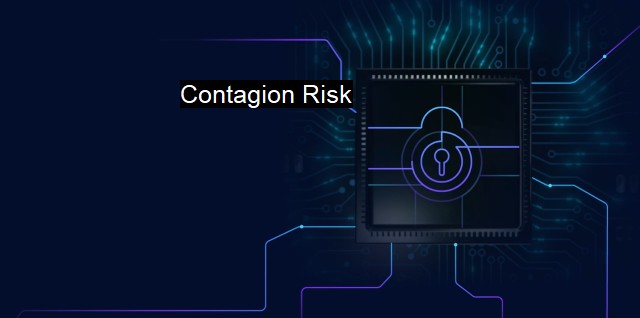What is Contagion Risk?
Contagion Risk in Cybersecurity: Preventing Widespread Damage from Malware
Contagion risk, with symbolizes a poorly studied yet remarkably consequential concept which takes into the realm of digital security to an uppermost level. Just as an infectious disease propagates through a population, contagion risk in cybersecurity relates to the cascading effects of a cyberattack, data breach, or a security failure that can penetrate through interconnected systems, causing significant damage in a domino-like effect.Cybersecurity contagion risk poses a profound risk on a global scale. Within a heavily digitalized environment where everything interconnected, one digital 'outbreak' could hike into an epidemic. Various entities, ranging from individuals, corporations, institutions, to governments, are progressively relying on digital networks, making them susceptible to cyber threats. The contagion risk aligns itself with these threats, mounting vulnerability on a mass scale because of the interconnected structure of these systems.
Understanding contagion risk in cybersecurity necessitates info about the interdependence of systems. Systems are interdependent when the functionality or security of one system relies on or affects another. This interconnectivity can occur at multitude of levels, physical, time, and logical being a few of them. A disturbance in one node, as a result, eases into other sectors, reflecting the contagious nature of the risk.
Contagion can happen for a variety of reasons. One key reason is the structurally designed homogeneity across systems’ aspects, including software, methods or algorithms, posing identical vulnerability and susceptibility to threats. This homogeneity across networks invites a sort of hubris for potential attackers, as the same misconstruction can be used multiple times on numerous targets with high penetration probability, escalating the contagion effect.
Inefficiencies in one system facilitating contagion risks include poor network hygiene, latent software or solutions, standardized protocols or structures, inadequate communication and control, and over-reliance on automation. Consequently, preventive security measures fall short in an environment where interconnected systems collectively become vulnerable due to a solitary factor.
Antivirus software could also get embroiled in contagion risks since advanced cyberattacks may target known vulnerabilities inside security software, aiming to strike upfront the security checkpoints, thereby spreading chaos with devastating impacts on other linked systems. Within this contingency, reliance on a single antivirus, or a group of antiviruses with the same structural design, acts as a beacon to severe contagion risk.
Contagion risk highlights hitherto unprobed cybersecurity challenges enmeshed within the managing of cyber-risks holistically, embracing the unpredictable mismatch between investigator’s judgment and the rapid adaptation of attacker. Potential solutions against these risks should seek to nurture heterogeneity across systems, breaking the likeliness and predictability which emboldens cybercriminals to reproduce attacks. Ensuring differential system designs, unconventional security protocols, an amalgam of manual and systematic security checks, and fostering informed strategizing amongst cybersecurity stakeholders could significantly mitigate contagion risk in systems interconnected digitally.
An integrated cybersecurity approach, focusing on a strong offensive strategy as much as a defense, can together create an interlocked step against contagion risk. It employs strategies that incorporate network segmentation, creative cyber hygiene practices, routine patching, and continuous monitoring combined with quick response mechanisms to neutralize threats ahead of infiltration.
Contagion risk in cybersecurity is a pervasive predicament stemming from the colossal collective reliance on digital networking. The challenge for cybersecurity investigators and antivirus software developers hence becomes not just to respond to individual threats but to understand potential domino effects that could precipitate system-wide vulnerabilities and contagions. This perspective obliges to be combined with advanced threat intelligence that helps anticipate and mitigate cyber contagion risks and ensure resilient and robust digital networks, favoring a safer, yet interconnected cyber environment.

Contagion Risk FAQs
What is contagion risk in cybersecurity?
In cybersecurity, contagion risk is the risk of a virus or other malicious software spreading across a network or system, infecting multiple devices or users.What factors contribute to contagion risk?
Contagion risk in cybersecurity can be increased by factors such as weak passwords, outdated software, lack of security updates, and user error.How can contagion risk be mitigated?
Contagion risk in cybersecurity can be mitigated through measures such as regular software updates and security patches, strong and unique passwords, antivirus and anti-malware software, and employee training and awareness programs.What are the consequences of a high contagion risk in cybersecurity?
A high contagion risk in cybersecurity can result in the spread of viruses, malware, and other malicious software, disrupting business operations and potentially leading to data breaches and loss of sensitive information. It can also result in financial losses, reputational damage, and legal consequences.| | A | | | B | | | C | | | D | | | E | | | F | | | G | | | H | | | I | | | J | | | K | | | L | | | M | |
| | N | | | O | | | P | | | Q | | | R | | | S | | | T | | | U | | | V | | | W | | | X | | | Y | | | Z | |
| | 1 | | | 2 | | | 3 | | | 4 | | | 7 | | | 8 | | |||||||